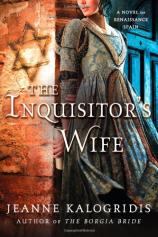Author Talk: May 9, 2013
THE INQUISITOR’S WIFE, Jeanne Kalogridis’s most recent work of historical fiction, follows Marisol Garcia, a young converso, as she navigates the Inquisition in renaissance Spain. When her father is arrested and tortured, Marisol must choose between her love for him and her duty to her people, and make dangerous alliances, including one with the ruthless queen herself. In this interview, Kalogridis addresses some common misconceptions about Queen Isabella, who wasn’t as meek or mousey as you might believe. She also talks about the ever-prevalent politics of identity, describes some of the snares of writing historical fiction --- including “research rapture” --- and shares a few enticing details about her next novel.
Question: What was the inspiration for THE INQUISITOR’S WIFE and its titular heroine?
Jeanne Kalogridis: I’d researched the Inquisition in 1300s France for my novel THE BURNING TIMES, and I’d always wanted to know more about the famous Spanish Inquisition (beyond the Monty Python sketch, “No one expects…”). So when I was casting about for an idea for a new novel, I decided to look at the origins of the Spanish Inquisition. I thought I already knew the basic facts, but the more I researched the topic, the more I realized that, like everyone else, I had major misconceptions about the Inquisition. I quickly became fascinated by the underlying politics, and by Queen Isabella’s real reasons for engineering the Inquisition. She was not the frail, pious saint of legend. And her husband Fernando was king in name only; Isabella was the real power behind the throne, although in writing she always deferred to her husband, claiming that she was simply going along with the king’s wishes. Although the two unquestionably loved each other, they regularly had knock-down, drag-out fights with much shouting and tears. And they all ended with Isabella getting her way. Interestingly enough, King Fernando had a Jewish ancestor, something that Isabella wasn’t above pointing out during their squabbles.
Q: Did you take any “artistic liberties” in telling this story? Could you share an example of how you altered a fact (or two!) for dramatic or thematic effect?
JK: My heroine is fictional, although her father is based on a real person; her mother is representative of the Inquisition’s targets. Everything else --- detailed descriptions of Isabella and Torquemada, dates, places, names, historical characters --- is as accurate as careful research allows. I did, however, take liberties: Queen Isabella probably never visited Seville during the period my novel takes place, so I had her make a “secret” visit because it made the story far more exciting and allowed us a glimpse of Isabella as she really was. Many older biographies give us the inaccurate picture of her as small, quiet, pious, and dark-haired. I relied on an excellent recent biography by Peggy Liss, and learned that Isabella was auburn-haired, big-boned, taller than most men (including Fernando), and fond of bawdy jokes. Politically, she was incredibly shrewd and ruthless. The image of her as intensely pious and resorting to the Inquisition as a result of that piety is inaccurate --- an example of Isabella’s brilliance at creating a consistent public image. She was a master at public relations. My rule for writing a historical novel is this: I never contradict an established fact but will allow myself to create “situations that might have been.” Beyond that, I work obsessively to re-create eras and personas as carefully as possible. For example, I have a character hide a mezuzah inside a statue of a Madonna --- a technique that had actually been used in Inquisitional Spain and Latin America.
I fear I suffer from the phenomenon known as “research rapture” --- details so delight me that I always do far too much research, never too little. Most of the heroines in my other novels, however, are based on actual historical figures. I departed from that with THE INQUISITOR’S WIFE.
Q: Can you tell us a bit more about your research? What was the most surprising --- or shocking --- thing you learned about this time period?
JK: I managed to get my hands on some great resources. There’s a marvelous 1,500-page history by B. Netanyahu (father of, yes, that Netanyahu) regarding the origins of the Inquisition. It’s incredibly detailed, with documents and letters from the period.
The single most surprising thing I learned (outside of Isabella’s real appearance and personality) was that the Spanish Inquisition did not persecute Jews. Church law actually forbade the persecution of Jews and protected them; the Church had no legal jurisdiction over them (although civil authorities did). Therefore, the Inquisition focused on Christians, specifically those “new” Christians who were conversos --- i.e., converts from Judaism. My story takes place in 1481, when the Inquisition first appeared in Spain; but back in the 1390s, prompted in part by hysteria over the plague, Spanish Christians slaughtered thousands of Jews. Those that survived the slaughter were forced to convert to Christianity at knifepoint.
The great majority of these conversos became sincere practitioners of their new faith. A few, however, continued to practice the rituals of Judaism in secret. This went on for generations. By Isabella’s time, many Old Christians still looked on conversos with suspicion. A very few conversos in Seville were blatant about their loyalty to their old religion, and this caused hostility and occasional violence.
Since the conversos were Christian, the Church had full authority to persecute them as heretics if there was any evidence that they were still practicing Judaism. Some of the conversos who were arrested and subsequently burned at the stake were in fact heretics by the Church’s definition, but many were falsely accused and completely innocent. Many fled Seville and settled south in Morocco, or east in Portugal (where the Inquisition took hold a century later).
I believe, as does Netanyahu and other historians, that Isabella shrewdly played on this antagonism between Old Christian and New in order to start the Inquisition. Before I did my research, I didn’t realize that the Spanish Crown seized the lion’s portion of any arrested converso’s wealth and property. Both the Church and the Crown made an obscene fortune off the Inquisition --- at a time when Isabella was actively seeking money to fuel wars.
The most frightening thing about the Spanish Inquisition was that Isabella and Fernando insisted that the pope give them complete control over the Inquisition. That had never been done before; monarchs were always answerable to the Church. As a result, there was no third party oversight, and no legal rights for the accused. For the first time in any Inquisition, the accused had no right to confront his accuser or even know who he was, and one could denounce one’s neighbor while remaining completely anonymous. Many innocents were denounced by enemies.
Q: What parallels, if any, do you find between the politics of identity then and now?
JK: Nothing has changed. Those seeking power still use racial, sexual, and ethnic divisions to their political advantage. They ruthlessly foment hatred for political purposes, dividing the world into “us” and “other.” Look at how unscrupulous politicians today are fanning the fires of hatred over issues like marriage rights and immigration reform.
Q: Do you personally know anyone who had to hide his or her Jewish identity during World War II, for example?
JK: Not personally, but I read Anne Frank’s THE DIARY OF A YOUNG GIRL when I was very young, and being a young girl who loved to write, I identified with her. It touched me deeply; it was hard for me to imagine that someone wanted her dead because of her DNA. I also grew up in the Deep South and witnessed the civil rights struggles firsthand; the Ku Klux Klan was very active in our little town, and even paraded in the streets. I remember the day that blacks were first admitted to our school --- how truly terrified those children were, how very cruelly other children treated them. It was sickening and heartrending to watch.
Q: Are you currently working on another book? And if so, what --- or who --- is your subject?
JK: I’m having a blast writing my current (untitled for the moment) book, which has a much lighter, fun feel and greased-lightning pace. It’s about a young woman who grew up in Florence, in the Ospedale degli Innocenti, Italy’s landmark orphanage. In those days, a fifteen-year-old girl in the orphanage was considered an adult, and had to leave. She was given two choices: Marry (usually an undesirable older man looking more for a servant than a real wife) or join a nunnery. Well, my heroine, Giulia, is too headstrong and independent to countenance either. She escapes to the street. Rather than become a prostitute, like most unmarried, uncloistered orphaned girls, she becomes a highly skilled pickpocket, giving most of her earnings to her fellow orphans.
The period is 1479-80, during Florence’s war with the King of Naples and the Pope of Rome. And Florence was losing big-time. Lorenzo de’ Medici, the first citizen of Florence, risked his neck by paying a secret visit to the King of Naples himself, and launched a one-man diplomatic campaign to save Florence using nothing but his wit and personal charm. It was an amazing, difficult time, and one of the most fascinating events of the Italian Renaissance.
My heroine Giulia will find herself entangled in the intrigue and espionage surrounding Lorenzo’s famous visit to Naples, at which point her life changes forever. Lorenzo is a pivotal character. The story starts two years after Giulia’s departure from the orphanage. We find her on page one with her hand in the pocket of a victim, just as an extremely attractive young policeman catches and arrests her...









